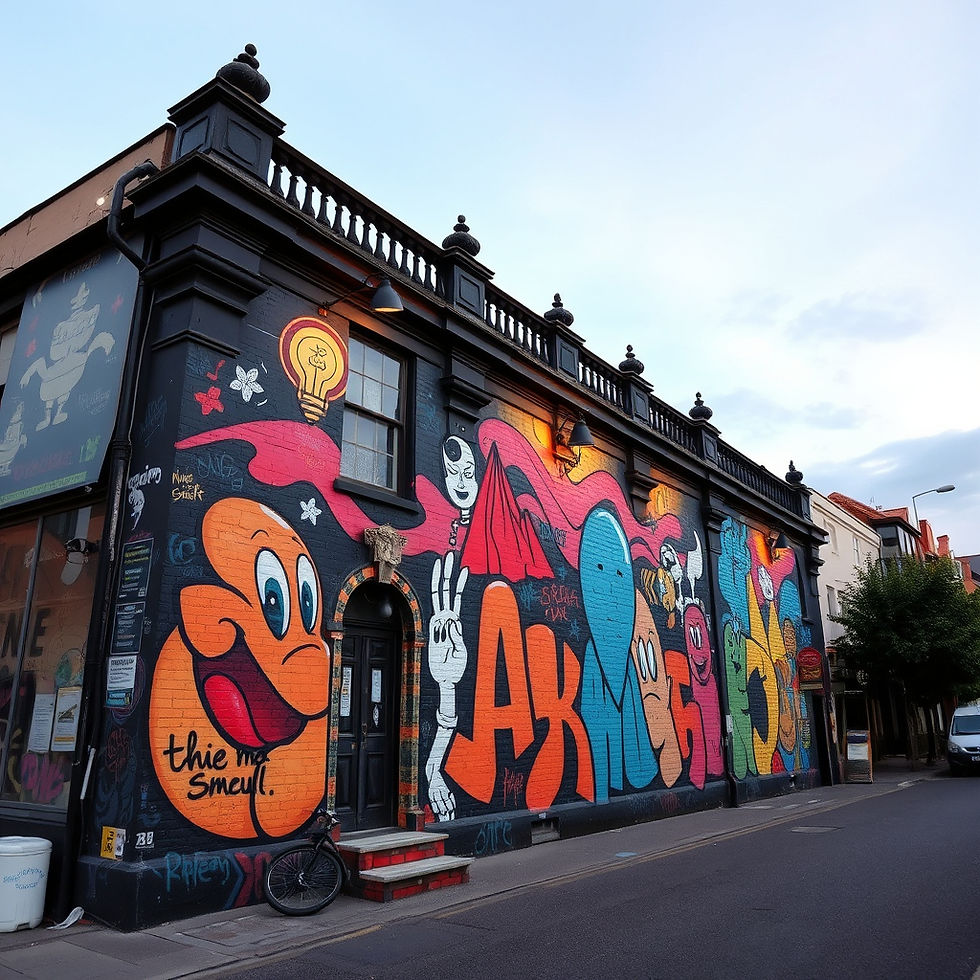Street Art: These walls really can talk
- Sara Begley
- Jun 19
- 3 min read
Call it old if you like, but cultural news can be hard to come by these days, so we’re gonna roll with it. On May 30th, Banksy incorporated the shadow of a street post into the simple silhouette of an old and weathered lighthouse. With the caption of “I want to be what you saw in me,” many are grappling with the meaning of this particular work.
Banksy shines a light on a Marseille Street
Banksy’s simple black and white street art features the simple lighthouse silhouette, with white beams of light escaping and the caption “ I want to be what you saw in me.” On Friday, May 30th, Banksy posted on his instagram an image of his work, with no caption, and no location. People and media alike quickly found the location to be 1 Rue Félix Frégier, in Marseille, a city in southern France.
Throughout his career, Banksy has been recognized as both subversive and political, which makes his most recent work in Marseille…….. confusing, to say the least. With no obvious arrows pointing to world conflicts or issues in the country, this work has many grasping for an uncharacteristically emotional interpretation. Theories that have been thrown in the ring include love, loss, sadness, redemption and more — leave it to an artist with vague words to make us question ourselves and our mental state.
Evolution of Street Art — It started as NYC names

Somehow, humanity evolved from handprints on walls to political and social messages in metropolises — the only question is how? Street art is popular and common all over the world, it's admirable. It is often found in urban areas, particularly public locations, often with social or political issues addressed within them.
Let’s take a trip back in time. Imagine, if you will, a big metropolitan city in the United States. Prime examples include New York City, Philadelphia, and Los Angeles. Back in the olden days, street art primarily consisted of early graffiti — names and words tagged in unsanctioned places. Street art continued to grow all over the world throughout the seventies, in New York, subways became canvases, with hundreds of names tagged on the cars. In Los Angeles murals became popular. In Mexico and Brazil, political works became prominent, and in Brazil pixação became common. Meanwhile in Europe, Paris was getting more street art, and the Berlin wall became a major political canvas. In the 80s, street art received more recognition as an art form, and made its way into museums and galleries. Outstanding artists who created street art began to gain recognition, and famous names include Blek le Rat, Banksy, Keith Haring, and Jean-Michel Basquiat. Street art spread to countries all over the world, becoming the global phenomenon that it is today.
Street art has an extensive and captivating history, and I did my best to capture the major points of it. For a more comprehensive history and importance, Artland Magazine has an excellent article.
Graffiti vs Street Art — A battle with no winners
There are so many important questions in human history. Where was Alexander the Great buried? Was there a real King Arthur? What happened at Roanoke? What is the difference between street art and graffiti?
The last one, at least, has an answer. Graffiti originated (for the most part) in the 1960’s, in major U.S. cities. (The Big Apple, Philly, The City of Angels, you get the point.) Then, graffiti was mostly words and names tagged on walls and subways, but street art grew from there. Street art consists mainly of images, stencils, and things of the like, whereas graffiti is made up of tags and lettering. Sometimes, street art can be commissioned, but often both street art and graffiti are unsanctioned, leaving street art a special experience for those who see it before it is covered up. Street art is much more welcome in most places, whereas graffiti is more often seen as vandalism. Largely, this is caused by intent. Street art features social and political messages and opinions, while graffiti is an example of personal expression, marking territory and gaining recognition.
Finally, the end of the walls' story. What did you think?
Street art is always growing and advancing, changing with both the political and social landscapes. Banksy came out with a work that has a very subtle political meaning, if there is one at all. Constantly evolving, street art is something to keep an eye on, with all the creativity and culture involved.


Very interesting